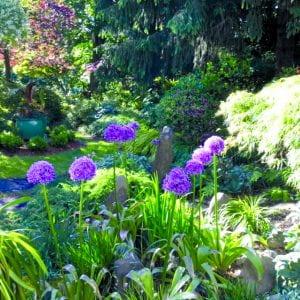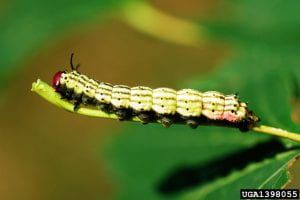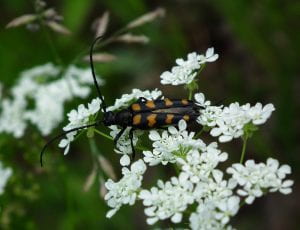Urban Sanctuary
By Cecelia Lillard, Florida Master Gardener Volunteer and James Alton Thomas, Greenville Township Senior Master Gardener Volunteer
This article appeared in the August 2019 Issue of Gardening in Orange County. Click here to subscribe!
This article profiles an urban lot that was transformed into an oasis for body, mind and soul as well as for wildlife. This lot belongs to a local Master Gardener and illustrates how much privacy, beauty and biodiversity can be created with thoughtful design and considered plant choices. We’ll review the design principles employed in this yard and then take a look at the ecological needs fulfilled through the design and its implementation.
 First and foremost, this design provides privacy and the sense that the space is an outdoor room. The lot is 50′ wide and faces southeast. The edges of the property are bordered by deciduous and evergreen trees. The tall Norway Spruce provides a strong anchor for the southern border and creates a shade garden for almost half of the yard, while the mature deciduous trees provide both frame and boundary for the property. Given that this garden is in shade much of the time, plant textures are emphasized in throughout the space. Since the plants are in groups instead of individual plants, the various textures become harmonious and interesting rather than chaotic to the eye. The repetition of plants by massing gives the design a simplicity that helps quiet the mind and gives one an opportunity to linger in areas and simply enjoy the beauty of a plant’s texture and color.
First and foremost, this design provides privacy and the sense that the space is an outdoor room. The lot is 50′ wide and faces southeast. The edges of the property are bordered by deciduous and evergreen trees. The tall Norway Spruce provides a strong anchor for the southern border and creates a shade garden for almost half of the yard, while the mature deciduous trees provide both frame and boundary for the property. Given that this garden is in shade much of the time, plant textures are emphasized in throughout the space. Since the plants are in groups instead of individual plants, the various textures become harmonious and interesting rather than chaotic to the eye. The repetition of plants by massing gives the design a simplicity that helps quiet the mind and gives one an opportunity to linger in areas and simply enjoy the beauty of a plant’s texture and color.

The central planter provides the main focal point of the yard and is the only place where we find a traditional lawn. The repetition of red in the plants helps to unify the yard and gives the focal point additional structure. The use of evergreen boxwoods around the base of the container ensures that the focal point will be held even in winter when the planter is moved indoors and allowed to go dormant.
The lawn around the focal point draws the eye to the back of the circle where a stone path peeks between the low shrubs and groundcovers. The curving shape of the path gives the landscape a sense of movement and entices one into the farther spaces. The copper birdbath provides another focal point that draws the viewer’s eye and invites the viewer to another part of the garden that is more private. The red pole, which supports an unseen, yet occupied birdhouse, gives us a hint that there is more to that part of the garden than we can see and provides a touch of mystery.
 The yard evokes a feeling of balance with the shrubs softening the borders of the property and the understory trees filling the gaps between the shrub layer and the canopy of the deciduous trees. The varying heights of the plants provide visual interest and contribute to the feeling of privacy that is created in such a small space. The repetition of color throughout the garden contributes to the sense of balance, with the yellow-greens contrasting with the darker greens, yet not competing with them.
The yard evokes a feeling of balance with the shrubs softening the borders of the property and the understory trees filling the gaps between the shrub layer and the canopy of the deciduous trees. The varying heights of the plants provide visual interest and contribute to the feeling of privacy that is created in such a small space. The repetition of color throughout the garden contributes to the sense of balance, with the yellow-greens contrasting with the darker greens, yet not competing with them.
Seasonal interest was also a major consideration in the design of this space. There is year-round interest provided by many elements of the garden. The plants were chosen not only for their texture, but for their bloom times and flower colors as well. There is a continuous supply of flowers in the garden throughout the spring and summer and into fall. The changing color of the leaves of the trees and shrubs during the autumn supplies the visual interest that flowers provided the rest of the season. In the winter, the evergreens take center stage, furnishing a stark contrast to the more delicate structures of the deciduous plants.
Overall this garden creation has a feeling of unity, where all of the parts work together to create a coherent whole. The massing provides a rhythm that is relaxing and the multiple textures provide interest within that rhythm. The reiteration of certain colors also unifies the space by visually connecting different areas of the property.

Looking at the yard from an ecological point of view, the property provides all the layers of a forest garden: tall tree layer, low tree layer, shrub layer, herbaceous layer, ground cover layer and, of course, the root layer. The tall tree layer consists of both deciduous and evergreen trees. These trees provide food in the form of seeds and shelter within their branches to birds and squirrels. The leaves of the deciduous trees also supply an important habitat for insects, including butterflies and moths, providing spaces to lay eggs and food for growing larvae.

Since the garden was designed to be in continuous bloom for more than half the year, it can be considered an insectary. There are various flower shapes throughout the garden, providing food for many different types of insects. Some insects prefer umbelliferous flowers, while others prefer flowers with central florets like asters. The diversity of flower shapes and bloom times helps ensure that beneficial insects will have a continuous food supply and will help keep invasive and/or problem insects at manageable populations.
As we have spent much of this issue discussing soil and the soil food web, we need to look at our garden through that lens. In addition to providing mulch and habitat for overwintering insects, fallen leaves contribute to the soil structure and organic matter content in the soil. These photos were taken in spring and we can see how full and lush the vegetation is early in the season. This verdure is due not only to the care of the gardener, but more so to the health of the soil where these plants are growing. The soil food web is very dynamic in an environment like this and the result is the beauty that we see in these photos. May you be inspired to use these design principles and nourish your ecosystem to build a beautiful garden of your own.
For links to resources that will help you design your own urban sanctuary, check out Cornell University’s “Site Assessment for Better Gardens and Landscapes“.
Click here to learn more about Backyard Conservation.
